|

On eBay Now...
🔥 Historic Important Original Museum RAY CHARLES Joe Adams Photograph ARCHIVE For Sale
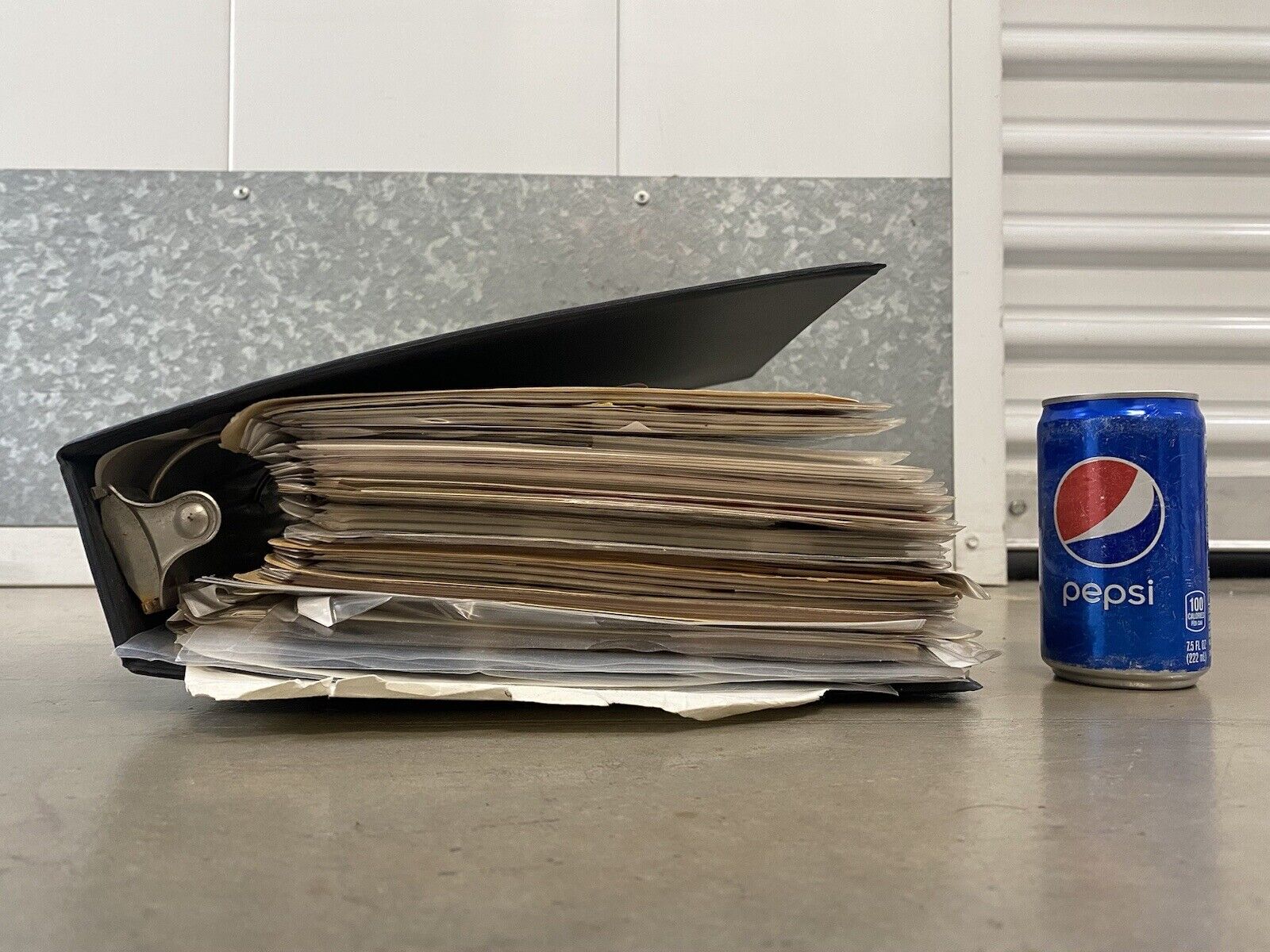
When you click on links to various merchants on this site and make a purchase, this can result in this site earning a commission. Affiliate programs and affiliations include, but are not limited to, the eBay Partner Network.

🔥 Historic Important Original Museum RAY CHARLES Joe Adams Photograph ARCHIVE:
$9500.00
This an exceedingly RARE and Historic Important Original Museum RAY CHARLES Joe Adams Photograph ARCHIVE, containing hundreds and hundreds, most never seen by the public, photographs, documents, and photographic negatives and slides related to legendary Jazz musician Ray Charles (1930 - 2004) and his lifelong manager and friend, Joe Adams (1924 - 2018), dating from the 1970\'s - mid 1990\'s. This large binder consists of innumerable (in the hundreds), massive amounts of press kit photographs, concert and event photographs, candid photographs, behind the scenes photographs, contact sheets, and early Ray Charles and Joe Adams photographs and includesTHE ORIGINAL NEGATIVES!This archive is absolutely worthy of a museum and was meticulously kept and attended to by Ray Charles\'s manager, Joe Adams, who kept this large binder in his personal office. It includes original film strips from Ray\'s famous concert with Johnny Cash in 1978, numerous hand-signed and dated photos of Ray Charles, personal letters, a Grammy Nomination document, hand signed photographs from Ronald and Nancy Regan, and very early photos of Joe Adams, several of which are original photographs by the important 20th century African - American Ebony Magazine photographerHoward Morehead, which bear hisoriginal studio ink stamp, etc. There are also a few original photographs which were taken, and ink stamped by Dave Pell (1925 - 2017), an early Westcoast Jazz pioneer. I am limited by to 24 photos, but this is a collection of several hundred individual and important original images. I\'ve done my best to upload pictures of the highlights (in my humble opinion,) but there is so much moreto be seen in this archive. Acquired from an abandoned storage unit in Los Angeles, California, containing historic and museum-worthy items and music memorabilia associated with Ray Charles (1930 - 2004) and Joe Adams (1924 - 2018).Priced to Sell.Guaranteed Authentic. If you want any additional information, please reach out and I will do my best to answer your questions!You are welcome to view this archive in person before purchasing. The financial, historical and marketing potential of this massive archive of original unseen photographs and negatives of Ray Charles and his associates arelimitless. Please check out my other new listings from this impressive and historically significant collection. My hope is that these items, and the others, will be purchased by a single collector or museum institution. If you like what you see, I encourage you to make an Offer. Please check out my other listings for more wonderful and unique items!About Joe Adams (1924 - 2018):
JOE ADAMS: A True Living Legend from Watts to the WorldPOWER, POISE & PRESTIGE: Legendary manager, actor and businessman Joe Adams is known as “The Man Behind The Man,” who guided the historical career of ‘The Genius’ Ray Charles, but he was much more than that.
The man who has preserved the legacy of Ray Charles was a barrier-breaking star long before ‘The Genius’ You may remember Joe Adams as the legendary manager of musical genius Ray Charles from the motion picture ‘Ray’, but what most people don’t know is Joe Adams was an entertainment innovator, actor, savvy businessman, and legend in his own right. In a rare one on one interview with the Sentinel, Adams reveals stories untold and provides a unique introspective into The Man who was behind The Man. It’s a bright sunny day in the city of Los Angeles and the historical landmark RPM International sits quiet on Washington Blvd. The piano keys are still; the wardrobe closet is flush with Ray Charles jackets, silk shirts, Bally\'s shoes and pants. The President of Ray Charles Foundation Valerie Ervin and the rest of us anxiously wait for the man who for many and has been known as the man behind the man. As he carefully navigates each step from the small parking structure up the stair chase into the studio that sits adjacent to the famous recording booth, Joe Adams has arrived. It is a location that he is all too familiar with because he was responsible for designing RPM International Studios where Charles’ genius expanded. There he was, slowed only by his biological clock that now stretches to 89, wearing a dapper purple silk shirt and stylish matching slacks. Adams who for more than four decades teamed with the revolutionary Ray Charles to form an entertainment business model that will never be duplicated, is still managing. These days he sits atop as the Chairman of the Board of The Ray Charles Foundation and his own foundation, the Emma and Joe Adams Foundation, carrying out the wishes that he and his friend shared years before Charles succumbed in 2004. He is responsible for shepherding the legacy of Ray Charles and implementing the philanthropic goals that both men had. It was Adams who presented Charles R. Drew University of Medicine and Science with a $1-million donation — the largest one-time individual gift in the school’s history in June. The money will be used to fund student scholarships and the donation comes from Joe Adams and his wife, Emma, and will establish the Adams Scholars, which will provide $10,000 to cover tuition for undergraduates based on their financial need. Additionally, Adams is responsible for millions of dollars in ongoing contributions to Morehouse College and a recent $600,000 donation to Spellman College through his charitable foundations. A Los Angeles native who was raised in Watts and proudly recalls his days as a student at Jordan High School, Adams spoke fondly of the influence he received from late Sentinel Publisher Col. Leon H. Washington. “Yes Col. Washington gave me a lot of good advice back then,” Adams remembered. Adams’ father was a local businessman who owned Gold’s Furniture store on Central Ave. during the late 1960s and 70s, and it was from him that Adams attained his keen sense for business and the astute value of money. Adams was the son of an African American mother and Jewish father, and his parents were a rare interracial couple at the height of racial segregation and prejudice in the early 1900s. During those days Adams was growing up in Watts when he began honing his talents to become a barrier breaker in radio broadcasting. It was during this time at a young age that he realized he wanted to do what no African American dared dream of. Adams wanted to become a radio announcer and practiced by shouting aloud in isolated parking lots. Experiencing the brunt of racism growing up as a child, he was determined to not allow his black skin to prevent him from reaching his goal. By the time he was a teenager he was the first African American on radio at Art Grogan’s owned Santa Monica Station KOWL, who gave Adams the opportunity to go on the air in the 1940s. Within two years Adam’s daily radio show was the #1 rated deejay show in Los Angeles. During an era when deejays were required to solicit their own sponsors, he attracted an incredible 56 paid advertisers to pay for airtime on KOWL, marking the beginning of an auspicious radio career that eventually spanned twenty years. Adams branched out into television with two shows of his own, “Adams Alley” for KLAC with a cast of twenty-eight people, and “Joe Adams Presents.” He was one of the pioneers of that era, hosting top-name stars and musical greats, among them was Charles. He also enjoyed success as a film actor, appearing in more than 26 motion pictures. Among his most notable roles was Husky Miller in Carman Jones and as Frank Sinatra’s psychiatrist in The Manchurian Candidate. His talent as an actor earned him the Foreign Correspondence Award as the Golden Globe Outstanding New Actor Award in 1958. He was the first African American man to win this award. He was a star long before he met Charles in 1958. When Charles invited him to be the master of ceremonies during his world tour in 1961, Adams was already a well-known major network radio personality and accomplished actor. Historically, Black performers had been controlled (and, too often, robbed) by white members of the music industry (agents, managers, accountants, lawyers), whose chief loyalty is to one another and not to their clients. However, in Adams, Charles discovered a loyal man who was also polished in business and law. He was retired before he decided to join Charles on tour, but subsequently went on to serve as an adviser-manager and their relationship in business was much like a marriage. Adams only could recall one time he had a disagreement with Charles; “We once had a mix-up that had something to do with a song, but I just left it alone and went on to New York and when I returned, he told me that I was right,” he told the Sentinel in an exclusive interview. Adams wasn’t just a trusted adviser and manager, but also the designer of all of his wardrobe, producer of shows and photographer. Their relationship lasted through the singer’s death. Some may scoff at the relationship that Adams and Charles had, but had it not been for Adams the success of the foundation would not be possible. “They needed each other more than anyone could ever imagine,” a confidant said. Today, Adams looks on as President, Valerie Ervin for whom he and Ray Charles both trained, oversees and is in charge of RPM International, and supervises the many activities of the parent company, including its business holdings and publishing companies, including Tangerine and Racer Music; as well as Ray Charles Enterprises, which covers the activities of the Ray Charles Orchestra and the Raelettes. Adams was at the helm of the Ray Charles Corporation until his retirement in 2008, he now serves as Chairman of the board appointed by Ray Charles. Although the couple does not have any children, among their gifts was the establishment of the Emma and Joe Adams Public Service Institute at Morehouse College in Atlanta, which supports students who balance academic excellence with a commitment to community service. As major individual donors to The Ray Charles Performing Arts Center, not only have they supported the facility financially with a $500,000 gift, they also are responsible for introducing Ray Charles to Morehouse and nurturing the relationship that yielded the vision for The Ray Charles Performing Arts Center. The facility’s concert hall is named after the couple. The couple has already substantially contributed to building a lasting legacy at Morehouse. Adams goes about his dignified life not looking for accolades or personal endorsements, but instead pondering how he can make the lives of those less fortunate better. Asked about his friend Charles, and Adams says; “I miss him,” solemnly. His friend would be proud to know that he is going about life, as he would have with him, all that’s missing is Charles being on tour and producing music. For Adams it’s a void that can never be filled, but there is a mission in life ahead and one that will not be complete without Joe Adams.
Joe Adams
Joe Adams(April 11, 1924 – July 3, 2018) was an American actor,disc jockey, businessman and manager. He was manager toRay Charlesand won a Golden Globe— the first African American to do so.Adams was a native of Los Angeles. His father was a Jewish businessman, and his mother was African-American.After being told that, because of his race, he should not try for a career in radio, Adams took an indirect route to reach that goal. He went from being a truck driver to being chauffeur and general assistant for Los Angeles radio personality Al Jarvis. After six months, Adams had become Jarvis\' assistant producer. Adams was the first African-American announcer onNBC\'s radio network,handling West Coast jazz remote broadcasts and producing segments of NBC\'sMonitorprogram.In 1948, he became a disc jockey and announcer onKOWLradio inSanta Monica, California,and 10 years later he was described in a newspaper article as \"the station\'s top personality and most valuable property\". Adams became the Emcee and stage director for the fourth Cavalcade of Jazz concert held atWrigley Fieldin Los Angeles which was produced byLeon Hefflin Sr.on September 12, 1948, and continued for the annual event for 10 more years. The event showcased over 125 artists over time.Dizzy Gillespie,Frankie Lane,Little Miss Cornshucks,The Sweethearts of Rhythm,The Honey Drippers,Joe Turner,Jimmy Witherspoon,The BlendersandThe Sensationswere all featured as Adams emceed his first Cavalcade of Jazz concert. On June 19, 1951, Adams began his own television program onKTTVin Los Angeles. The show featured Adams\' 15-piece orchestra, vocalist Mauri Lynn, and the Hi Hatters dance team. In 1954 Adams played boxer \"Husky Miller\" in the award-winning \"Carmen Jones\" film opera featuring an all-black cast headed by Best Actress Oscar-nomineeDorothy Dandridge. On stage, Adams had the role of Joe Nashua in the Broadway musicalJamaica(1957).
Adams married Emma Millhouse in 1946.They remained married until his death 72 years later.
TheLos Angeles City Councildesignated March 15, 1953, a day to honor Adams.In 1955, he receivedFEMmagazine\'s Man of the Year Award.
Adams\' photographs, scrapbooks, and other materials are housed in the Joe Adams Papers collection in the Archives Center, National Museum of American History of theSmithsonian Institution.
Joe Adams, Longtime Manager of Ray Charles Dies at 94On Tuesday, July 3, the longtime manager of legendary musicianRay Charlesand former Chairman of the Board of The Ray Charles Foundation, Joe Adams died at the age of 94 in Los Angeles. Charles and Adams designed and built the RPM International office and studios on Washington Boulevard in Los Angeles. As the CEO in charge of RPM International, Adams supervised the many activities of the parent company, including its business holdings and publishing companies, Tangerine and Racer Music. His work with Charles extended to Ray Charles Enterprises, which covered the activities of the Ray Charles Orchestra and the Raelettes. Adams produced Ray Charles’ numerous appearances overseeing every details from stage lights to Charles’ wardrobe–which he personally designed for not only Charles but the Raelettes as well. A Los Angeles native who was raised in Watts, Adams was the son of an African American mother and Jewish father. Adams’ father was a local businessman who owned Gold’s Furniture store on Central Ave. during the late 1960s and 70s, and it was from him that Adams attained his keen sense for business and the astute value of money.
During the 1940s, as a teenager Adams was the first African American deejay at the Art Grogan owned Santa Monica based radio station KOWL-AM. Within two years, Adam’s daily radio show was the #1 rated deejay show in Los Angeles. During an era when deejays were required to solicit their own sponsors, Adams attracted an incredible 56 paid advertisers to pay for airtime on KOWL, marking the beginning of an auspicious radio career that eventually spanned twenty years. In addition to radio, Adams enjoyed success on both television and in film as an actor appearing in more than 26 motion pictures. Among his most notable roles were as Frank Sinatra’s psychiatrist in “The Manchurian Candidate” and as Husky Miller in “Carmen Jones”–the latter of whichearned Adams a Golden Globefor New Star of the Year in 1955 making him the first African American man to win the award. An integral part of the renowned Tuskegee Airmen, Adams honed his skills and later became a qualified commercial pilot. Among his many talents and skills, Adams was a professional photographer and well versed in entertainment contract law Adams was at the helm of the Ray Charles Corporation until his retirement in 2008. For ten years he served as the Chairman of the Board of the Ray Charles Foundation where he was responsible for shepherding the legacy of Ray Charles and implementing the philanthropic goals that both men had. He and his wife Emma established The Emma and Joe Adams Foundation where they donated millions to support educational institutions. It was Adams who presented Watts’ Charles R. Drew University of Medicine and Science with a $1-million donation— at the time—the largest one-time individual gift in the school’s history. The money funded student scholarships and established the Adams Scholars which provides $10,000 to cover tuition for undergraduates based on their financial need. Additionally, Adams was responsible for millions of dollars in ongoing contributions to Morehouse College and a $600,000 donation to Spelman College. Funeral arrangements are pending and will be announced at a later date.
About Ray Charles (1930 - 2004): Ray Charleshas been called \"the genius of soul,\" a true pioneer of American soul music. The Albany, Georgia-born musical prodigy, blind since the age of 7, defied formidable odds to become one of the foremost icons in the history of modern American music. Born Ray Charles Robinson in 1930, after his family moved to Greenville, Florida (near Tallahassee) Charles was soon enrolled at a state-supported school for the deaf and blind in St. Augustine, Florida, in 1937. During his eight years there, Charles received a formal music education, mastered Braille and learned to play piano, organ, clarinet, trumpet and saxophone. On summer breaks, he occasionally entertained relatives in Tallahassee\'s black district, known as Frenchtown. At 15, he left school to join the South\'s so-called \"chitlin\' circuit, performing at gigs throughout the south, mostly in black dance halls in Orlando, Tampa and Jacksonville, where he lived briefly. In Tampa, he played for a southern band called The Florida Playboys, wearing his signature sunglasses for the first time. It was in Tampa that he made his first three recordings. In 1948, Charles left Florida for Seattle, Washington, to pursue better opportunities in music. There he met 14-year-old Quincy Jones, and the two developed what would become a close personal and professional relationship for the rest of Charles\' life. Charles soon dropped his last name \"Robinson,\" mainly to avoid popular confusion, since boxer Sugar Ray Robinson had become a household name in the U.S. He soon landed a record contract and moved to Los Angeles with a newly formed group, the McSon Trio. It was with this trio that a recording first brought Charles into the national spotlight. In 1951, the single \"Baby Let Me Hold Your Hand\" jumped to #5 on the nation\'s R&B chart. The 1950s was a decade of phenomenal success for Charles. First signed to Atlantic Records, he scored his first No. 1 hit with \"I Got a Woman,\" a song that combined elements of gospel music with blues. The wildly popular recording spawned a new musical genre that eventually would become known as soul music. Charles ended the decade on a high note with the single \"What\'d I Say.\" The song topped the R&B chart in 1959 and was Charles\' first cross-over hit. The 1960s brought a string of smash hits, many of which not only became Charles\' all-time signature songs, but also were unprecedented blends of soul, blues, jazz and country western sounds. Such hits as \"Georgia on My Mind,\" \"Hit the Road Jack,\" \"You Don\'t Know Me,\" and \"Crying Time,\" ably demonstrated Charles\' extraordinary grasp of the full range of American pop music. When he died (of liver cancer) in 2002, Ray Charles had conquered not only the music world, but also a 20-year addiction to drugs. His legacy—underscored by a dozen Grammy Awards, three Emmy nominations, inductions into the Rock, Jazz and Rhythm and Blues halls of fame, among a long list of other honors—is generally regarded as an essential and indelible element in the bedrock of American pop music. On the eve of his death, Hollywood paid its own tribute with Ray, a film depicting Charles\' life. The movie starred Jamie Foxx, whose portrayal of Charles won him the 2004 Academy Award for Best Actor.Charles got the chance to work with the film\'s director but died before the film\'s debut in 2004. He is buried in Los Angeles.
About Howard Morehead (1926 - 2003): Howard Morehead, 79; Photographer of Jazz Musicians Broke Color BarrierHoward Morehead, pioneering African American photographer who captured jazz greats for album covers and such international leaders as Nelson Mandela for newspapers, magazines and television, has died. He was believed to have been 79. Morehead apparently died July 13 at Veterans Memorial Hospital in West Los Angeles of complications of cardiovascular disease, said Tom Reed, a longtime friend and producer and host of “Black Accent on Los Angeles” for KSCI-TV Channel 18. Morehead had no known relatives, and friends were uncertain about the exact circumstances of his death.
Reed said Morehead had taken about 30% of the photographs illustrating his 1992 book, “The Black Music History of Los Angeles -- Its Roots.” Among those was the moody cover photo of saxophonist Dexter Gordon, which Morehead shot in 1957. A native of Topeka, Kan., Morehead served as one of the Tuskegee Airmen in World War II and later studied photography at Los Angeles City College and motion picture photography at USC. He worked as a news photographer for the Los Angeles Sentinel in the 1950s, and in 1958 became the first West Coast staff photographer for Johnson Publications, which showcased his work in its Jet and Ebony magazines. In 1970, Morehead became the first African American staff cameraman to work at a Los Angeles television station -- KTLA-TV Channel 5. Later that decade he switched to KABC-TV Channel 7 here. “It’s not that I was the best, but I just happened to be the first,” Morehead told Los Angeles Scoop in 1994. But he said it wasn’t easy achieving that breakthrough. “I would go to the TV stations and they would tell me, ‘Well, we can’t hire you, you’re not in the union.’ I would go to the union and they would say, ‘Unless you’ve worked with a TV segment, we can’t let you in.’ ” He said he broke the impasse by shooting background footage in the Fiji Islands for Raymond Burr’s “Ironside” television series -- a job he later described as “a vacation you would pay to go on.” Morehead both excelled and reveled in photographing the musicians he loved to listen to while he worked. His favorite subject was Ray Charles, who disliked being photographed, but was put at ease when Morehead played recorded jazz during their sessions. The photographer captured Charles for covers of several albums, including “Rhythm and Blues Meets Country and Western,” “I’m All Yours Baby,” “Ingredients in a Recipe for Soul,” and “Just Between Us.” He shot Charles in his studio, in offices, in a private home before a raging fireplace, at the Hollywood Bowl and on the set of the “Dinah Shore Show.” He photographed Charles with Shore, Frank Sinatra, Aretha Franklin, Liberace and others. “I wish all of the musicians and models I have photographed were as easy as Ray to direct,” Morehead once said. Other top-rank musicians who came before Morehead’s all-seeing cameras were Louis Armstrong, Count Basie, Miles Davis, Billy Eckstine, Duke Ellington, Dizzy Gillespie, Benny Goodman, Billie Holiday, Thelonious Monk, Bobby Short and Mel Torme. Stephanie Evans, another friend, said a memorial is planned for Monday at the Whiffendale Club, Adams Boulevard and 5th Avenue, Los Angeles.
Another Side of Ray CharlesExhibit Details the Late Musician, and the Man Who Photographed Him for 40 Years- by Kristin Friedrich
- Jun 20, 2005
Howard Morehead died in July 2003, leaving behind no known relatives and little fanfare. But a glimpse at the recently opened exhibitI Shot Ray Charles, at Exposition Park\'s California African American Museum (CAAM), reveals Morehead as one of the last century\'s important, if lesser-known, L.A. photographers. Morehead took pictures of jazz greats, Rat Packers, African American beauties, nature landscapes and Angeleno Shriners. As the cliche goes, every picture tells a story. But the greater story might be the shooter himself. Born and raised in Topeka, Kan., Morehead served as one of the Tuskegee Airmen in World War II. He moved west for college; he attended UCLA, studied photography at L.A. City College and film at USC. Morehead joined theLos Angeles Sentinelnewspaper as a photographer in 1950, became the first West Coast staff shooter for Johnson Publishing Company (which meant covers and centerfolds for magazines such asJet and Ebony), and in 1970 was hired as the first black cameraman at KTLA Channel 5. He later moved to KABC and worked there 17 years until he retired. Despite his foray into TV, Morehead is best known for still photography, especially his pictures of the late Ray Charles. Morehead donated many jazz shots to UCLA during his life, and his estate gave a batch to Charles\' family upon the musician\'s death in 2004. Last year, the executor of Morehead\'s estate donated the bulk of the photographer\'s archives to CAAM. Charmaine Jefferson, CAAM executive director, says the collection includes more than 500 photographs, as well as contact sheets, negatives and archival material. After Charles\' death, Jefferson was going through the museum\'s archives, looking for some pictures to commemorate the jazz great. While searching, she came across an essay called \"I Shot Ray Charles,\" typed and written by Morehead. \"We had been trying to figure out how to do a show with this work that ranged fromJetgirls to Kenyan sunsets,\" Jefferson said. \"I thought, how better to introduce people to Howard Morehead than through an icon people are into right now.\" There are no beauties, landscapes or shriners inI Shot Ray Charles.Instead, the exhibit offers an intimate look at the musician and his work. Contact sheets capture rehearsals with backup singers, the Raelettes; Charles working with his composers and producers; and a chat between Charles, his manager Joe Adams, and Frank Sinatra, who called Morehead \"the Genius.\" Morehead was in the studio when Charles, Aretha Franklin and Billy Preston cut their famous Coca-Cola commercial. There are shots with the oddball, but also oddly quintessential, 1960s trio of Dinah Shore, Liberace and Charles, goofing around backstage before taping Shore\'s show. There are no pictures of Charles at home, but there are many of him at work on stages and in studios. Throughout the exhibit are anecdotes from Morehead. The lensman said that Charles was never unaware of the camera - he had a famously keen ear, and would chide Morehead when he heard the shutter clicking (Charles could hear it even over loud music). But at least Morehead could get him to relax. He was one of the few shooters, for instance, who captured Charles studying words to songs on Braille lyric sheets. Morehead had two tricks for keeping Charles\' impatience at bay: sax-heavy mix tapes the photographer made for photo sessions, and a sexy model, such as the one on the cover of the albumI\'m All Yours - Baby.The contact sheets for that shoot are on display in addition to the album. They show Charles clearly enjoying himself. The show is petite, with only about 40 pictures (six lesser-known Charles tracks play on speakers in the background, including Stevie Wonder\'s \"Living for the City\" and a duet with Aretha Franklin). But it\'s only the beginning of the Morehead experience: CAAM\'s Jefferson says that as the museum works through the archives, more of his pictures will see the light of day. I Shot Ray Charlesruns through Nov. 5 at CAAM, 600 State Dr.
Online Archive of California
DescriptionHoward Morehead was a photographer, broadcast news cameraman, and impresario. A native of Topeka, Kansas, he moved to Los Angeles after World War II and joined the staff of theLos Angeles Sentineland did freelance work for a number of magazines. He also founded the Miss Bronze California beauty pageant as a reaction to the systematic discrimination faced by African American women. The collection consists predominantly of photographs of musicians and venues documenting the Los Angeles jazz scene from the mid-1950s through the 1990s. There are also a number of actors and politicians represented. There is a very large amount of glamour photography featuring models and beauty pageant contestants. Some personal and business papers are also present, as well as books, videotapes, and sound recordings from Morehead\'s personal collection.BackgroundHoward Morehead was born in Topeka, Kansas in 1926. After graduating from high school, he enlisted in the Army Air Corps and was assigned to Tuskegee Army Airfield, where he began training as a pilot in anticipation of joining the pioneering Tuskegee Airmen. The war ended before he saw combat, and after his discharge from the military he moved to Los Angeles.

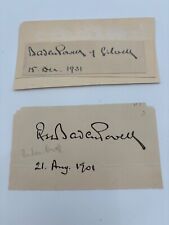
Robert Baden Powell Autograph's $725.00
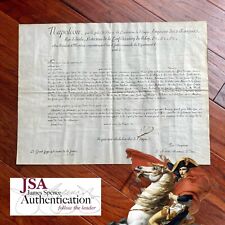
NAPOLEON BONAPARTE * JSA * Autograph PARDON Signed as Emperor * 1810 * Tuileries $3750.00
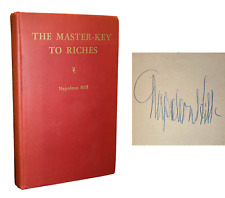
Napoleon Hill ~ Signed Autographed "The Master-Key to Riches" 1st Ed. ~ JSA LOA $1995.00
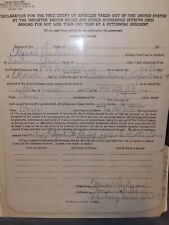
Super RARE 1955 Marian Anderson Signed US Custom Form $275.00
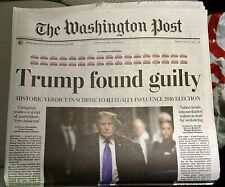
Washington Post Historic Headline May 31, 2024 Trump Guilty $18.00
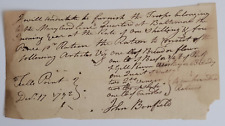
1792 NOTE MILITARY TROOPS TULLS POINT MARYLAND JOHN BONFIELD AMERICAN REVOLUTION $100.00

Tiger Woods x23 ~ Signed Autographed L.A. County Junior Golf Auto ~ Beckett BAS $650.00
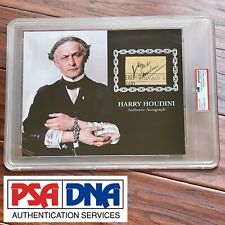
HARRY HOUDINI * PSA/DNA * Autograph Cut Signature Signed Display * Magician $2500.00
|